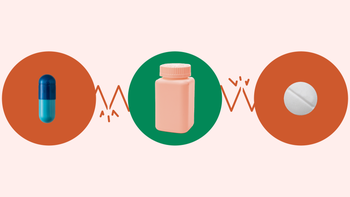
When Should I Worry About Leg Cramps? How to Tell If It’s Harmless or a Blood Clot
Key takeaways:
Leg cramps and blood clots in the leg can both cause pain in your calf muscle.
Some symptoms can help differentiate whether your pain is from a cramp or a blood clot. Leg cramps tend to go away on their own and aren’t harmful.
Deep vein thrombosis (DVT) typically causes one-sided leg swelling, redness, and warmth that worsens over time. A blood clot in your leg can be more serious and require medication to prevent further complications.

Leg pain and cramping are common and often result from muscle spasms. While this pain can feel severe, it’s usually not serious. But sometimes what feels like a leg cramp may actually be something more serious: a blood clot in your leg, also called deep vein thrombosis (DVT).
Here, we’ll review both conditions, provide some clues to help tell the difference, and discuss what to do next.
What are leg cramps?
A leg cramp — sometimes called a “charley horse” — is a painful muscle spasm. It happens when a leg muscle suddenly tightens, usually for a brief period (a few seconds to minutes). This most commonly happens in your calf muscle. But it can also happen in the muscles of your thighs or feet.
Causes of leg cramps
Leg cramps can have many different causes, including:
Tired muscles
Nerve damage due to neuropathy or trauma
Electrolyte abnormalities, like low potassium or magnesium levels
Kidney disease, which often affects electrolyte levels
Dehydration
Pregnancy
Medications like diuretics for blood pressure, statins for cholesterol, and long-acting beta agonists (LABAs) for asthma
While there are many causes of leg cramps, most of the time it’s not clear why they happen, and they often go away on their own. But in some cases, a leg cramp can be caused by a blood clot.
Can deep vein thrombosis (DVT) be cured? These common treatments for DVT are helpful in managing the condition.
DVT risk factors: Find out what makes DVT more likely to occur.
What does DVT feel like? Three people share their journey with DVT and the symptoms they experienced.
Signs that your leg pain may be serious
A leg cramp can be a sign of DVT, which happens when your blood clots inside a vein.

DVTs more commonly occur in the smaller veins that travel deep within your lower legs. But they can also occur in other veins throughout your body. The most common symptoms include:
Swelling: This may be visible just in your foot or below your knee, or it can affect your whole leg.
Pain: People often describe a constant, dull pain in your calf, knee, or thigh.
Redness of the skin: The redness is usually faint and spread out.
Warmth: The skin over the affected area may feel warmer than the rest of your skin.
Many times, these symptoms only occur in one leg. But sometimes a DVT (or multiple DVTs) can cause symptoms in both legs. Many other conditions, like cellulitis or lymphedema, can also cause these same symptoms. So, DVT can’t be diagnosed by symptoms alone.
Usually, an ultrasound is needed for diagnosis. It’s also important to note that DVT doesn’t always cause noticeable symptoms, and many people may not know they have one. In fact, up to 40% of people with DVTs may have no symptoms.
Quiz: Do I have DVT?
How to tell the difference between leg cramps and a clot (DVT)
Leg cramps and DVTs can feel similar. But there are some differences that can help tell them apart:
Timing: DVT symptoms are usually subtle at first and then gradually increase over days. Cramps, on the other hand, typically start suddenly, feel severe, and last only seconds to minutes before going away. Cramps also most commonly occur in the middle of the night.
Swelling: New, one-sided leg swelling is more worrisome for DVT. Leg cramps can result from conditions that cause swelling (like kidney disease), but this swelling is typically there all the time
Warmth and redness: DVTs can cause noticeable redness and warmth in your leg, but this is much less common with cramps.
When to seek care if you are worried about a leg cramp
No one expects you to make this diagnosis on your own. A healthcare professional may order blood tests or do an ultrasound of your veins if they think you may have a DVT. If you have leg pain that is worrying you, reach out to a healthcare professional for help, especially if:
Your symptoms feel severe or are significantly impacting your daily activities
You have new swelling, redness, or warmth in your leg that wasn’t there before
You have risk factors for DVTs or blood clots
You have an increased risk of developing a DVT for many different reasons:
Immobilization: Anything that decreases the amount you use your legs can increase your risk of blood clots. This includes recent surgery, hospitalization, bedrest, or even prolonged travel, like a long flight or road trip.
Medical conditions: Certain conditions can make your blood more likely to clot. Some examples are inherited blood disorders, autoimmune diseases, and cancer.
Pregnancy: If you’re pregnant or recently gave birth, you’re at higher risk because increased estrogen levels affect the way that our blood clots.
Medications: Some types of birth control, like the combined oral contraceptive pill, may increase your risk of blood clots — but only by a small amount. Your risk goes up if you also have other risk factors for blood clots. Hormonal replacement therapy pills can also increase your risk of blood clots — but estrogen injections, creams, patches, and gels don’t.
Seeking help is important because DVTs can lead to a more serious condition called pulmonary embolism (PE). This happens when parts of the clot break off and travel to your lungs. It can cause symptoms like:
Shortness of breath
Chest pain
Fainting
PE is a potentially life-threatening condition because it affects your oxygen levels and, in some cases, your blood pressure. If you’re experiencing any of these symptoms, it’s best to see a healthcare professional right away or go to an emergency room to get them checked.
Frequently asked questions
Some research suggests that low levels of certain vitamins — like B12, D, and K2 — may cause leg cramps. Low levels of magnesium may also play a role. It’s a good idea to check with a healthcare professional to see if your leg cramps are related to a deficiency.
Hydration is one natural remedy that can provide good relief for leg cramps. Leg cramps are also sometimes caused by electrolyte imbalances, so foods and drinks high in sodium, potassium, calcium, or magnesium may help. This includes:
Electrolyte sports drinks (like Gatorade, Powerade)
Bananas
Coconut water
Sweet potatoes
Beans
Spinach
In addition to DVT, other conditions can cause symptoms similar to a leg cramp. These include conditions like:
Restless leg syndrome
The bottom line
Leg cramps and DVTs can have similar symptoms. But there are some clues that can help you figure out if you should see a healthcare professional. DVTs typically cause one-sided leg swelling, redness, and warmth that worsens over time. Leg cramps tend to occur at night, come on suddenly, and get better after a few seconds or minutes. If you think you may have a DVT or are unsure, it’s best to seek medical attention as soon as you can.
Why trust our experts?


References
Allen, R. E., et al. (2012). Nocturnal leg cramps. American Family Physician.
Bauersachs, R. M. (2012). Clinical presentation of deep vein thrombosis and pulmonary embolism. Best Practice and Research: Clinical Haematology.
Bilbey, D. L., et al. (1996). Muscle cramps and magnesium deficiency: Case reports. Canadian Family Physician.
Centers for Disease Control and Prevention. (2024). Testing and diagnosis for venous thromboembolism.
Centers for Disease Control and Prevention. (2024). Understanding your risk for blood clots with cancer.
Centers for Disease Control and Prevention. (2024). Understanding your risk for blood clots with pregnancy.
Centers for Disease Control and Prevention. (2024). Understanding your risk for blood clots with travel.
Garrison, S. R., et al. (2012). Nocturnal leg cramps and prescription use that precedes them: A sequence symmetry analysis. Archives of Internal Medicine.
Middeldorp, S. (2016). Inherited thrombophilia: A double-edged sword. Hematology.
National Heart, Blood, and Lung Institute. (2022). What is peripheral artery disease?
National Institutes of Health. (2017). How to spot and prevent deep vein thrombosis.
Tan, J., et al. (2024). Vitamin K2 in managing nocturnal leg cramps: A randomized clinical trial. Journal of the American Medical Association Internal Medicine.
Young, G. (2015). Leg cramps. British Medical Journal Clinical Evidence.
Your Vascular Health. (n.d.). Chronic venous insufficiency.

























